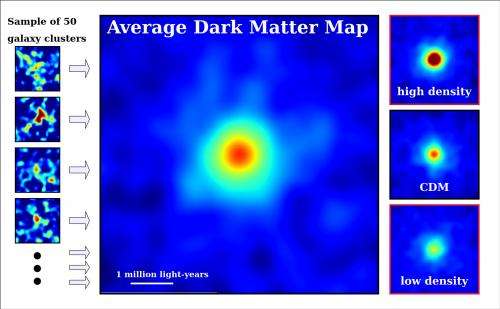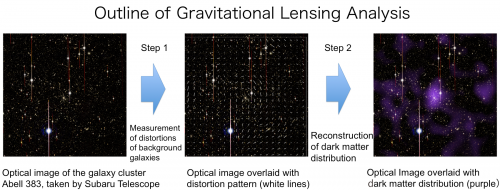Cosmic giants shed new light on dark matter

(Phys.org) —Astronomers at the University of Birmingham (UK), Academica Sinica in Taiwan, and the Kavli Institute of Physics and Mathematics of the Universe in Japan, have found new evidence that the mysterious dark matter that pervades our universe behaves as predicted by the 'cold dark matter' theory known as 'CDM'.
At a press conference today in Taipei the team of astronomers report their measurements of the density of dark matter in the most massive objects in the universe, namely galaxy clusters. They found that the density of dark matter decreases gently from the centre of these cosmic giants out to their diffuse outskirts. The fall in dark matter density from the centre to the outskirts agrees very closely with the CDM theory.
Almost eighty years after the first evidence for dark matter emerged from astronomy research, few scientists seriously doubt that it exists. However astronomers cannot see dark matter directly in the night sky, and particle physicists have not yet identified the dark matter particle in their experiments.
"What is dark matter?" is therefore a big unanswered question facing astronomers and particle physicists, especially because there is strong evidence that 85% of the mass in the universe is invisible dark matter.
The team, led by Dr Nobuhiro Okabe (Academia Sinica) and Dr Graham Smith (Birmingham), used the Subaru telescope in Hawaii to investigate the nature of dark matter by measuring its density in fifty galaxy clusters, the most massive objects in the Universe.
"A galaxy cluster is like a huge city that you view from above during the night', explains Smith. 'Each bright city light is a galaxy, and the dark areas between the lights that appears to be empty during the night are actually full of dark matter. You can think of the dark matter in a galaxy cluster as being the infrastructure within which the galaxies live. We wanted to know how the density of dark matter changes as you drive from the centre of a these huge cities out to the suburbs."

The density of dark matter depends on the properties of the individual dark matter particles, just like the density of everyday materials depends on what they are made of. CDM - the most successful dark matter theory to date - predicts that dark matter particles only interact with each other and with other matter via the force of gravity, they don't emit or absorb light. It also predicts that the density of dark matter in the centre of the most massive objects in the universe, for example the Coma cluster of galaxies - the nearest cosmic giant to Earth - is lower than in less massive objects, including individual galaxies like our own home, the Milky Way.
Observing galaxy clusters with the Subaru Prime Focus Camera (Suprime-Cam), the team measured the density of dark matter in galaxy clusters using the effect of gravitational lensing. As predicted by Einstein, gravitational lensing is the change in the direction and shape of a light beam as it travels through the curved space close to a massive object. The apparent shape and position of distant galaxies that astronomers observe are therefore altered by the dark matter in cosmic giants.
Lead author Okabe enthused, 'The Subaru Telescope is fantastic machine for gravitational lensing. It allows us to measure very precisely how the dark matter in galaxy clusters distorts light from distant galaxies and gauge tiny changes in the appearance of a huge number of faint galaxies.'
CDM theory uses two numbers to describe how the density of dark matter in galaxy clusters changes from the dense centre to the low density outskirts. One number is simply the mass of the galaxy cluster, and the second is the so-called concentration parameter - CDM theory predicts that galaxy clusters have a low concentration parameter (less dense central regions), in contrast to individual galaxies that have a high concentration parameter (more dense central regions).
The team combined observations of 50 of the most massive known galaxy clusters into a single measurement of the average concentration parameter of massive galaxy clusters. They found that the concentration parameter, that describes how density changes from the center to the outskirts of clusters, matches the CDM theory.
In the past, astronomers have studied small handfuls of clusters, finding that they generally have large concentration parameters, suggesting possible problems with CDM theory. Okabe and Smith suspected that if they used a large number of clusters to measure the average concentration parameter, then they might get a different result. 'We didn't know what we would find', comments Okabe, 'we were curious what we would find, if we took a different approach.'
After several years of observations, and careful data analysis, the results speak for themselves. The concentration parameter of galaxy clusters in the nearby universe matches CDM theory.
Hints that measurements of dark matter in large numbers of galaxy clusters might support CDM theory emerged in 2010 when this team published their preliminary results in the Publications of the Astronomical Society of Japan. They recently won that Society's 2012 Excellent Paper Award for that work, and are now enjoying the fruits of their hard work to improve their analysis and expand their study in the intervening years. "This is a very satisfying result. Our new results are based on a very careful analysis of the best available data," comments Okabe.
What does the future hold for the team's continued research on dark matter? Smith noted 'We don't stop here. For example, we can improve our work by measuring the dark matter density on even smaller scales - right in the centre of these galaxy clusters. Adding measurements on smaller scales will help us to learn more about dark matter in the future.'
Team member Professor Masahiro is also excited about the future: "Combining lensing observations of many galaxy clusters into a single measurement like this is a very powerful technique. Japanese astronomers are preparing to use Subaru Telescope's new Hyper Suprime-Cam (HSC) to conduct one of the biggest surveys of galaxies in human history. Our new results are a beautiful confirmation of our plan to use HSC for gravitational lensing studies."
More information: The research paper on which this release is based was published online in the May 17, 2013 edition of the Astrophysical Journal Letters: N. Okabe et al., "LoCuSS: The Mass Density Profile of Massive Galaxy Clusters at z=0.2", Volume 769, Number 2, Article ID. 35 (2013). iopscience.iop.org/2041-8205/769/2/L35/
Journal information: Astrophysical Journal Letters
Provided by University of Birmingham





















